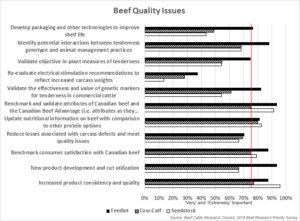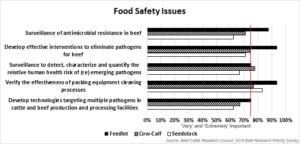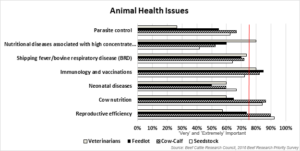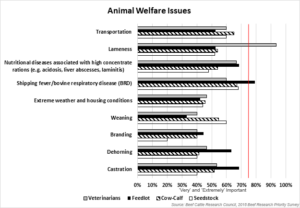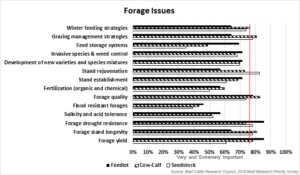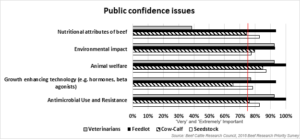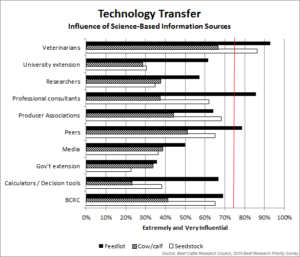Results of the Beef Research Priority Survey
How Your Input is Influencing Future Research
Earlier this year the BCRC developed an online Beef Research Priority Survey. The Survey asked participants to rate the importance of research issues listed in the 2012 National Beef Research Strategy.

We were very pleased to receive over 500 responses.
Over half of the respondents were producers. Most were cow-calf producers (49%), with smaller numbers of seedstock breeders (5%) and feedlot operators (4%). Other responses came from veterinarians, researchers, abattoir staff, government staff and industry staff.
Every province was represented. More producer responses came from western (85%) than central and eastern Canada (15%). Nearly half of the responses were from producers 40 years of age or younger. This indicates that the producers who responded to the survey are more likely those looking forward to a long future in the beef industry.
We sifted through all of the responses in detail with greater focus on the responses provided by producers, as well as veterinarians’ responses where appropriate (e.g. animal health, welfare and antimicrobial issues). We paid special attention to issues that were identified as ‘very’ or ‘extremely’ important by at least 75% of producers and vets, as well as issues that were rarely rated as ‘very’ or ‘extremely’ important. We also compared responses between eastern and western Canada for issues where geography may be expected to play an important role (e.g. forage and feed grain issues).
Here’s what you told us…
Beef Quality Issues
Increased consistency and quality, benchmarking consumer satisfaction with Canadian beef, updating nutritional information with comparison to other proteins, and benchmarking and validating attributes of Canadian beef and the Canadian Beef Advantage were high priorities to seedstock, cow-calf and feedlot respondents. Feedlot respondents also identified validating the effectiveness and value of genetic markers for tenderness in commercial cattle, potential interactions between tenderness genotype and animal management practices, validating objective in-plant measures of tenderness, and packaging and other technologies to improve shelf life as high priorities.
Food Safety Issues
All cattle sector respondents indicated that verifying the effectiveness of packing equipment cleaning processes was a clear priority. Surveillance to detect, characterize and quantify the relative human health risk of (re)emerging pathogens was a priority to cow-calf and feedlot respondents. Feedlot respondents identified all additional food safety issues (developing technologies targeting multiple pathogens in cattle and beef processing facilities, developing interventions to eliminate pathogens for beef, and surveillance of antimicrobial resistance in beef) as high priority.
Animal Health Issues
Reproductive efficiency and cow nutrition were priorities for seedstock and cow-calf respondents. Immunology and vaccinations were a high priority to cow-calf, feedlot and veterinarian respondents. Shipping fever/bovine respiratory disease (BRD) was a priority to feedlot respondents. Nutritional diseases associated with high concentrate rations (e.g. acidosis, liver abscesses, laminitis) were a priority to veterinarians. Neonatal diseases were not identified as a high priority, which suggests that we should probably have called that ‘newborn calf diseases’.
Animal Welfare Issues
Research studying individual animal welfare issues were rarely classed as very or extremely important. Lameness was a much higher priority to veterinarians than to livestock respondents. The contrast between animal welfare as an important Public Confidence issue and the relatively low importance placed on individual welfare research issues may not have occurred if we had referred to “pain management” or “science-based regulation” in the questions about dehorning, branding, castration, lameness and transport.
Feed Grains and Feed Efficiency Issues
Barley and corn yields were not viewed as particularly important by many respondents. Comments indicated that this work should be supported by seed companies or the grain sector rather than by cattle producers. This approach has been effective for corn breeding. Corn’s separate male and female flowers have allowed private breeding companies to develop genetically superior hybrid lines that will not breed true if seed is saved and replanted. This ensures future seed sales, and provides private breeders with the incentive to pursue further breeding efforts, including the use of biotechnology to incorporate additional agronomically beneficial traits. Barley’s self-pollinated nature makes commercial development of hybrid lines very difficult. Farm-saved barley seed greatly limits the breeder’s ability to recoup variety development costs. Because of this, barley and other small grain breeding has remained in the public realm with support from industry and government funding agencies.
Identifying and evaluating alternative feeds and feeding strategies, and the impacts of feedlot management on feed efficiency was important to feedlot respondents. The impact of feed quality on feed efficiency was important to both feedlot and cow-calf respondents. Identifying genetic markers for feed efficiency was more important to seedstock respondents than to cow-calf or feedlot respondents. Feedlot respondents considered differences in feeding costs between either high and low residual feed intake cattle to be relatively unimportant for both cows and feeder cattle. This may reflect a lack of confidence in the commercial relevance of residual feed intake as a predictor of feed-to-gain.
Numerous comments reflected concerns about how selection for improved feed efficiency in high energy diets may impact efficiency and other economically important traits in range production situations. Several comments also mentioned the need for simple, cost-effective, accurate chute-side tests to identify efficient animals in feedlot production environments.
Forage Issues
Improved forage yields were a priority for both cow-calf and feedlot respondents, and improved forage stand life and forage quality were priorities for cow-calf respondents.
Regional differences were evident for some issues. Drought resistance and forage stand rejuvenation were higher priorities for B.C., Alberta and Saskatchewan respondents than for those from Manitoba, Ontario, Quebec or the Maritimes. Eastern producers also placed less priority on salinity and acid tolerance than western producers. Flooding tolerance was a lower priority for both western and eastern producers, possibly because flooding is often a predominantly local concern.
Both western and eastern producers considered grazing management and winter feeding strategies to be high priority issues.
Public Confidence Issues
All livestock respondents rated nutritional attributes of beef, animal welfare, antimicrobial use and resistance and environmental impacts of beef production as high priorities. In response to the question “Are there additional priority areas that should be added?”, nearly half of producer respondents suggested environment-related issues such as carbon sequestration, greenhouse gas, environmental impact, biodiversity, and ecosystem services. Growth enhancing technologies were a high priority for seedstock and feedlot respondents.
Extension and Technology Transfer Issues
We asked how frequently various sources of science-based information are accessed, and how influential those sources are in decision making.
There was little difference between the frequency of access or influence of science-based sources of information between producers in Eastern and Western Canada.
Seedstock, cow-calf and feedlot respondents reported using social media most frequently to learn about science-based information. Following social media, magazines and newspapers, websites and blogs, radio, and smartphone apps are used most frequently to access scientific information.
The survey results found that veterinarians are the most influential or relied upon source of science-based information in decision making, particularly for seedstock and feedlot producers. Following veterinarians, producers’ peers, producer associations, and the BCRC were rated most influential. Feeders reported relying on professional consultants more than seedstock producers, and much more than cow-calf producers.
How we used the survey results
The trends that emerged from the survey were used to inform the subsequent discussions that occurred at the National Beef Research Workshop this summer. Workshop participants included producers, veterinarians, pharmaceutical reps, consultants, breed and industry association staff, researchers, and research funding agencies. There was only room for 125 participants at the workshop, and actual producers were in the minority so the producers’ survey responses were tremendously helpful in providing additional independent voices to the conversation.
The workshop attendees were divided among four main groups: beef quality and food safety, forage and grassland, feed grains and feed efficiency, and animal health and welfare. Each group was also asked to identify relevant public confidence issues relevant to the topic.
Before these discussions started, the groups were presented with the pertinent survey results, a summary of how major funders had been investing their funds in that area, and key results that had been emerging from the research that had been completed in recent years.
Armed with this knowledge, the various groups then discussed and identified which issues have likely been adequately ‘solved’, those which need more study or a new approach, and entirely new issues that need to be studied.
The outcomes of this workshop ultimately evolved into the 2016 Canadian Beef Research and Technology Transfer Strategy, which will be published in the coming weeks. The Strategy will help Canada’s cattle, forage and beef research funders guide their investments over the next few years, and will also provide a blueprint for research funding under the third Beef Cattle Industry Science Cluster.
Thank you to everyone who completed and promoted the Beef Research Priority Survey. We sincerely appreciate your interest and input in the long term competitiveness of the Canadian beef industry.
Click here to subscribe to the BCRC Blog and receive email notifications when new content is posted.
The sharing or reprinting of BCRC Blog articles is welcome and encouraged. Please provide acknowledgement to the Beef Cattle Research Council, list the website address, www.BeefResearch.ca, and let us know you chose to share the article by emailing us at [email protected].
We welcome your questions, comments and suggestions. Contact us directly or generate public discussion by posting your thoughts below.
